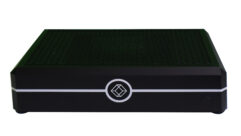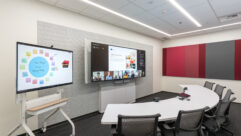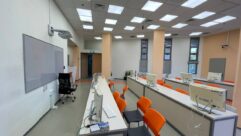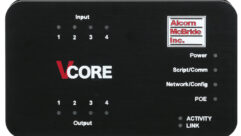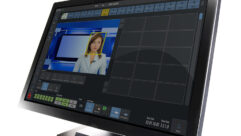
Technology Showcase:
AV Room-control Systems
Apr 1, 2006 12:00 PM,
By Bennett Liles
The marketplace is growing with customized and flexible AV control units.
Crestron RoomView
With the convergence of IP and AV firmly established, the list of companies offering solutions in the area of IP-controlled management of AV assets is expanding. There are a variety of creative approaches to controlling, configuring, monitoring, and organizing AV devices in multiple room environments, which is an especially interesting aspect to this field. These AV resource management schemes have different flavors for university, corporate, and government environments, but, unlike most strictly hardware issues, they all allow a certain degree of the integrators’ and programmers’ creative individuality to shine through.
The most effective custom AV control solutions naturally originate from those who perform daily system use and interact with other users. AV techs who can program the control software and connect the hardware of a particular plant have an inside track if they know the personalities of frequent users and are familiar with their individual tastes, habits, and levels of technical capability.
For this reason, it has become advantageous for inhouse techs to know how to do some after-market re-programming and configuration. Most of the products in this expanding market have responded with increasingly simple user interfaces and hardware configuration. Relatively simple re-programming of firmware functions through a laptop COM port has evolved from the intricate programming and compiling typical of the older, though highly flexible, AV control products. Ingenious design of the latest products has made it possible to maintain a high degree of individual customization while simplifying the setup and operation. Favorable market response has assured that trends will continue.
The strategy for strictly software vendors is to allow clients to keep much of their existing network hardware and employ it in new ways for AV control, a primary selling point being open-source compatibility and scalability — our software will work with your hardware. Other companies offer a range of hardware-control interfaces, which rely on firmware programming to provide the needed flexibility. Others offer hardware with proprietary software programming and control protocols. These require a fairly high degree of programming ability and some code writing, but they offer a high level of customization through a relatively complex configuration process. In most cases, training is provided for dealers and qualifying users in programming and configuration software.

AMX NI-4100
WHAT’S OUT THERE
A traditional heavyweight in the AV market, AMX offers a huge range of control solutions. Among its newest central resource controllers is the NI-4100, which debuted Feb. 1 at Integrated Systems Europe (ISE) 2006. With an exterior similar to its predecessor, the NI-4000, the NI-4100 packs twice the memory — 64MB RAM — and adds three times the processing speed. Memory is further expandable with 64MB to 1GB compact Flash. Intended for larger rooms with a variety of AV devices, the NI-4100 offers eight IR ports, eight I/O, eight relays, and seven RS-232 / RS-422 / RS-485 ports. It also provides native support for ICSNet, AXLink, and Ethernet networks, along with four NetLinx Control Card expansion slots for all NXC control cards. Dynamic Device Discovery allows automatic recognition of connected devices. Duet-compatibility combines AMX’s NetLinx with the programming power of the Java2 MicroEdition (J2ME) platform, and it automatically installs the appropriate module to install the recognized device. The current price on the NI-4100 is $4,200.

Aurora Multimedia WACI NX+
For non-proprietary flexibility and a range of AV room control features, Aurora Multimedia has a winner in its WACI NX+ IP control system. Setup and operational access are handled through any web-authoring application and browser. The ultimate in hardware hookups and user friendliness, the WACI NX+ is expandable for growing needs with the addition of ports, video streaming, battery backup, power over Ethernet, and hard drive storage with NX expansion modules. Add only the features you need, when you need them, including a Type II compact Flash expansion port. In addition to versatile AV control elements, the WACI NX+ also records, and stores audio and video files for play on demand. Programming elements can include Flash, HTML, DHTML, SOAP, XML, Visual Basic, CGI, and RPC to allow some interesting and creative possibilities for control pages. A range of browsers can be used for access, including Internet Explorer, Mozilla Firefox, Netscape Navigator, and Apple Safari. Multiple levels of password-protected access and encryption provide security. At around $1,200 for the basic unit, it’s a real bargain.

Bitlogix NetControl
For plantwide IP control of projectors, plasma displays, and LCD monitors, Bitlogix offers a software solution with its NetControl application. The software supports more than 380 makes of projectors and runs on Windows 2000, XP, and Windows Server 2003. In many cases, a separate hardware IP interface is not needed and the Cat-5 may be connected directly to the RJ-45-equipped display unit. Projectors on the network may be turned on or off with an event scheduler, and there is a cable-disconnect notification feature along with status reporting. When used with the NPC-1 TCP/IP interface, a networkwide search may be done to locate and display a list of all compatible devices. System requirements include an Intel Pentium II 400MHz or compatible computer, 64MB RAM (128MB recommended), 23MB hard disk space, and an XGA- or higher-resolution monitor. Bitlogix NetControl has been test-approved for use with IP interfaces, including the Eiki NPC-1; Extron IPL T S-2, S-4, and S-6; the Lantronix UDS-10 and 100; the Sena HelloDevice LS-100, PS-100, and SS-100; and the Sharp AN-LS1.
Calypso Control Systems has introduced a new product that offers a very light and simple but flexible solution to IP-based AV resource control. In a box measuring 5.1″×2.5″×1.1″, the ION-LT device control projector dongle can be positioned almost anywhere, including the projector mount. Two IR, one serial and one relay interface, can control various devices, and 128 events or 512 actions may be scheduled through the database incorporated into the onboard web server. Simple access and operation are made possible with Calypso’s patent-pending c_Link. This allows hyperlink control from a variety of applications such as PowerPoint and desktop icons. The training curve is virtually eliminated because no code writing is required. The wall-mounted CW-1000 controller, featuring single-touch cloning, can perform local programmable control, including IR learning. For rooms with more devices to control, ION 4s may be used, which offer four RS-232 interfaces. The ION 8i provides eight relays and one serial interface, while the ION 16i can supply 16 general-purpose inputs and one RS-232 interface. All ION units come in a compact half-rack-wide 1RU case. The MSRP for the ION-LT is $395.

Crestron RoomView 7.0
While Crestron can field myriad hardware devices for every phase of AV control, perhaps the most vivid example of the evolution in user power is RoomView 7.0, the latest version of Crestron’s AV asset control software. This edition offers an entirely new level of functionality over previous versions. Stretching its reach to more than 1,000 rooms, RoomView 7.0 maintains the PC-based interface for Windows clients and adds web client support for Windows, Mac, Unix, and Linux. A new tab-topped GUI guides users through the AV plant from various angles, including people, rooms, attributes, assets, schedule, and setup. The most interesting new feature is My RoomView, a custom-tailored area for each user that includes room information and plug-in modules. Each user can customize the colors, layout, and information to suit his or her personal preference. A Hot List module groups rooms according to where there are devices with critical readings such as connection errors and help requests. Other capabilities include instant messaging to and from selected rooms, voice communication, and webcam control. The PC-based client application requires Windows XP Pro and the web-based client uses Windows 2003 server. The 25-room version is free to Crestron dealers and the Enterprise version, with virtually unlimited room handling capacity, lists for $5,000.
In December, Dukane announced the release of ConVA version 2.1, the latest release of the company’s ConVA media control system. This software solution is available in two editions, Administrator and Presenter. Presenter enables control of all connected devices in one room, along with usage logs for the room and individual room device scheduling. The Administrator application provides control and monitoring features for an entire campus, including security items. Individual AV devices are connected through one of three compact hardware interfaces referred to as Protocol Converters. The base model provides a power input, IP interface, serial port, and three IR outputs or sensor inputs. The basic theory of operation is activity oriented. For example, when a user selects the Watch DVD mode, several things can happen: The screen can come down, the DVD can start playing, and the lights can dim. The user screen will change to display DVD controls along with always-on functions such as system power, sound level, and mode selects. Version 2.1 has introduced automatic software update checks, administrator Asset Status Reports through email or automatic computer display, and easier sharing of log data. A five-seat license for the product is $399 per room; the price drops to $199 per room as more licenses are purchased.

Extron MLC-104 GlobalViewer
Extron has expanded its already vast line of AV room control products with a line of hardware panels that offer higher functionality while going back to simpler operation. The MLC-104 IP is part of Extron’s MediaLink series, and it incorporates IP Link components so the control panel connects directly via RJ-45 with the LAN for remote monitoring and control with the GlobalViewer application. The simple panel layout and ability to configure each button for multiple simultaneous functions allow even the most inexperienced users to operate the AV sources with confidence. Automatic timed shutdown of AV resources is programmable using the integrated clock/calendar, and the backlit buttons are easy to see when the lights are dimmed for presentation. A hardware volume control indicates level with LEDs and shows maximum and minimum volume settings with a flashing LED. The unit is also available in the MLC-104IP AAP version, which incorporates a larger panel for mounting DVD and VHS transport controls in the form of the DVCM and other such modules. GlobalViewer is free with the purchase of any IP Link control product, and it presents a very user-friendly remote control and monitoring interface. Once the IP address information is assigned to the local IP Link unit, easy configuration and operation follow. The basic MLC-104 IP panel retails for a little more than $800.

FSR RN-8200A Room Navigator
For AV room control through local touchpanels, wall plates, frontpanel controls, and IP remote, FSR offers the rack-mounted RN-8200A Room Navigator. The IR, serial, audio, and relay devices attach on captive screw connectors while the video connections can use either BNC or S-Video DINs. This versatile unit combines a 4×1 RGBHV switch, 8×1 composite, and S-Video switches with simultaneous handling of composite and S-Video on inputs five through eight. Sound is assigned through an 8×1 switcher that can assign any audio input to any video input, balanced or unbalanced. In addition, the RN-8200A has four serial ports, four IR ports using single-head IR emitters, and four dry contact closures. Either of two wall-plate controls may be used. The basic model provides source selection, audio and projector mute, along with volume control and six user-definable buttons. The advanced wall plate offers 12 user-defined buttons, transport controls, and menu navigation keys, all through RS-485. Options extend to IP control with an integrated web server. Video outputs include RGBHV on HD-15 female, composite on BNC female, and S-Video on four-pin DIN. The rack unit lists for around $2,000.
Users of the ControlMate Media Controller from MediaTech are greeted with an innovative blend of advanced functions and user friendliness. The MT-444-CM-SL offers remote IP monitoring and control with an RJ-45 interface as well as local RS-232 control and configuration on a DB-9. The unit features four bidirectional serial ports with baud rates ranging from 1200bps to 57,600bps, four power-adjustable IR control ports, and four normally open relay contact ports. The controller offers user-configurable email alerts, an integrated IR learner capable of learning normal and toggling IR commands, mixed command sequences, and time-elapsed auto-execute commands. The onboard web server makes an easy and customizable remote IP user interface possible. Virtually any contact closure scenario can be configured through combinations of set/reset, timed pulse, and toggle relay operation modes. The MT-444-CM-SL provides instant local feedback through front-panel LEDs and the MT-444-CM product series can be configured as part of a larger solution with additional modules and mounted button controllers. Initial custom configuration is made with a Windows-based software utility included with the product. The unit currently retails for $1,295. MediaTech offers a range of application-specific product packages incorporating module combinations in the series.
Procon Technology provides programmable four-, six-, eight-, and 16-button control panels with the 84 and 85 series. Each is available with two to four RS-232 control ports, two IR/RS-232 ports, and an onboard I/O port. With slave panels added, up to 24 programmable buttons may be used in one system. Each button is macro-programmable for a series of events to occur in a button press, button release, or button toggle mode and may be configured for single operation or grouped with other buttons. One nice feature for display booth and kiosk scenarios is the ability to program auto-run events to occur in continuous loops for extended automatic operation. Programming software is included for total setup and upload of complete configurations. Remote RS-232 panel access and unauthorized panel lockout offer secure config and automation. Pre-made silk-screened buttons identify common functions and custom button labels are available from Procon in batches of 50. Once installed, the buttons display an attractive blue backlight for easy identification of active elements. The Procon 8404 includes RS-232 control and monitoring, infrared expansion, and learning units with low voltage and AC relay switching. The 8406 provides a six-button control panel with either four RS-232 ports or two RS-232 and two IR control ports. Unauthorized disconnect alarms are also programmable. The units are available in grey, white, or brushed aluminum. The Pro 8404 lists for $495, and the Pro 8406 is $695.
Among the software solutions for AV room control and monitoring is an open-source dual application offered by Simtrol. For device control, Simtrol provides the OnGoer application for Windows 2000 or XP. The product is designed to allow clients to use virtually any off-the-shelf interfacing hardware they choose to maximize economy and to offer an upgrade for a variety of existing hardware. The Builder app provides an interface for simple programming and initial configuration using Simtrol’s OnGoer Basic scripting language, but more customized configuration is possible with Visual Basic. Integrators are presented with a three-step process for system configuration. The first step is selecting the devices to be controlled. Next, specific control protocols are chosen, and then the user interface is designed. All of the particulars are stored in the OnGoer’s BILD files. The Technician application allows tech help people to monitor camera pan/tilt positions, lamp hour readings, and other parameters and monitor communication between OnGoer and local devices. Device control may be exercised as well. The optional OnGuard monitoring software may be installed on a server for graphical browser displays of assets and conditions. Alerts are programmed to notify tech support of lamp-life issues and unauthorized disconnects among other events. OnGoer is priced on a controlled device schedule beginning at $360 per device for one to five units, and the price continues to drop as more units are added: 100 or more controlled units are priced at $300 per device. OnGuard may be added to controlled devices for $100.
As can be seen here, among IP-controlled AV asset management solutions, the clear challenge is to lead the trend toward greater flexibility while enhancing the friendliness of the user interface.
For More Information
AMX Corporation
www.amx.com
Aurora Multimedia
www.auroramultimedia.com
Bitlogix Software
www.bitlogix.com
Calypso Control Systems
www.calypsocontrol.com
Crestron
www.crestron.com
Dukane
www.dukcorp.com
Extron
www.extron.com
MediaTech
www.gomediatech.com
Procon Technology
www.proconusa.com
Simtrol
www.simtrol.com


